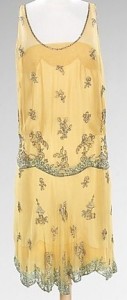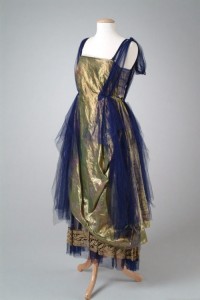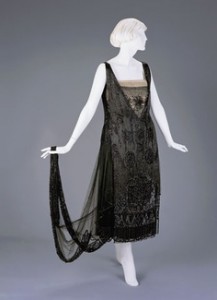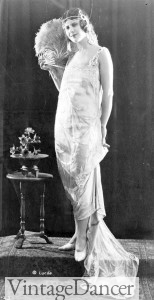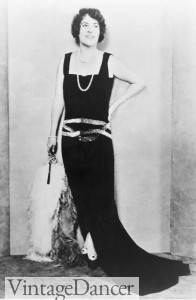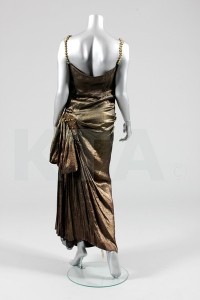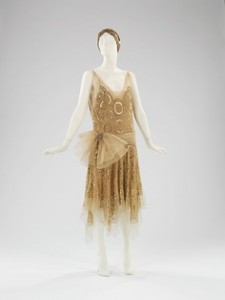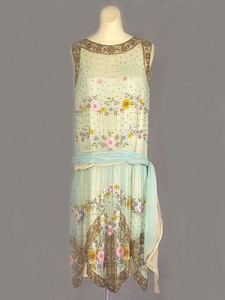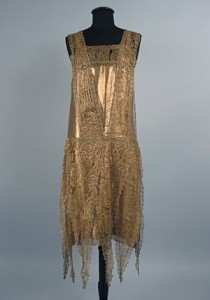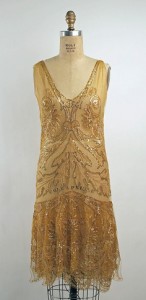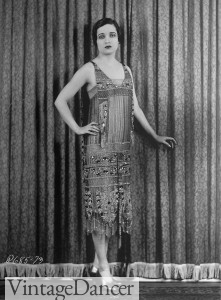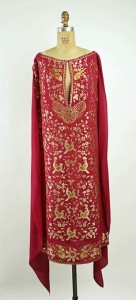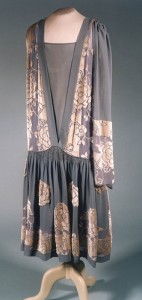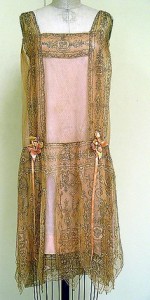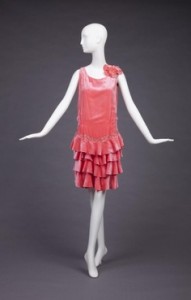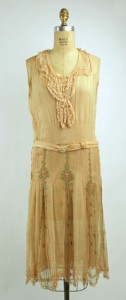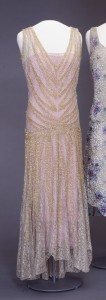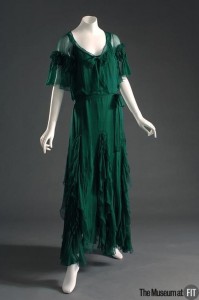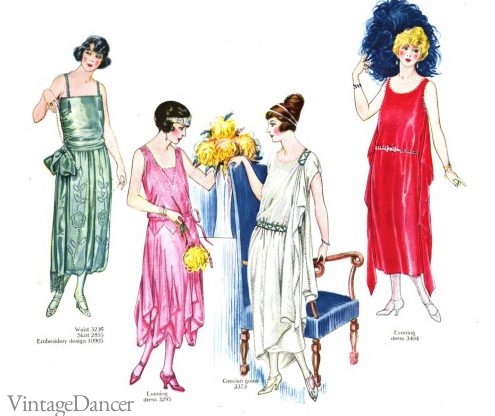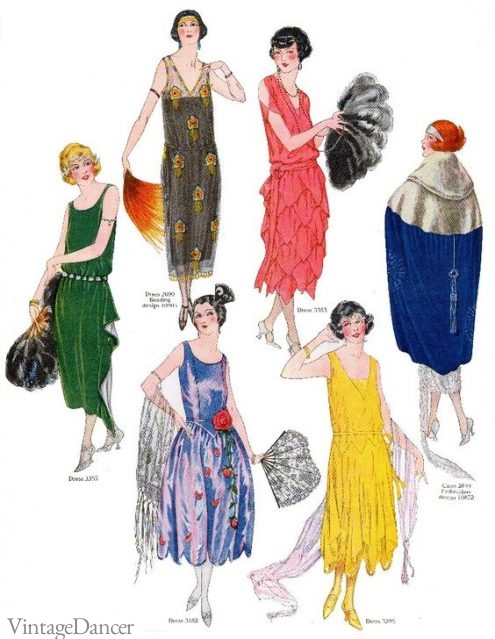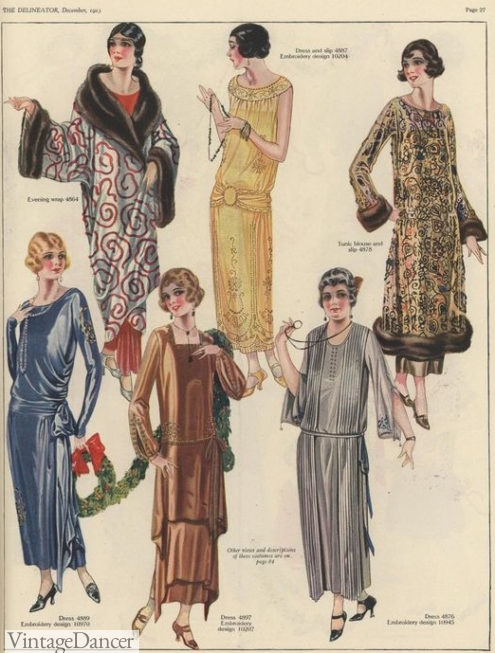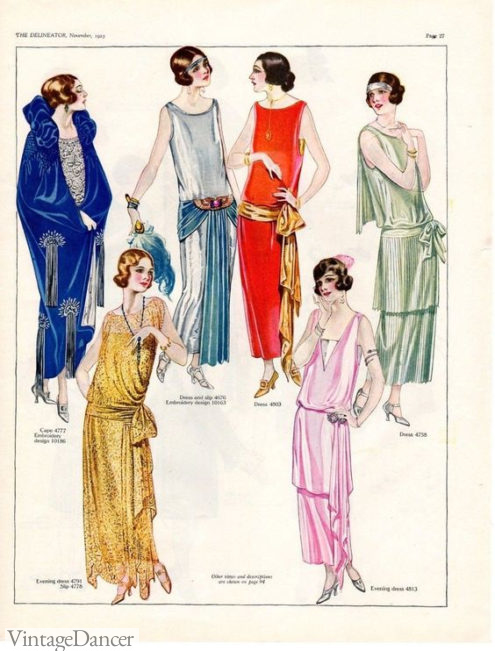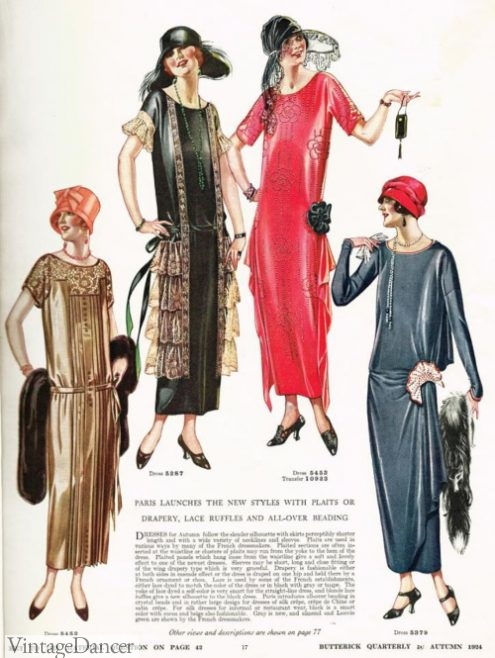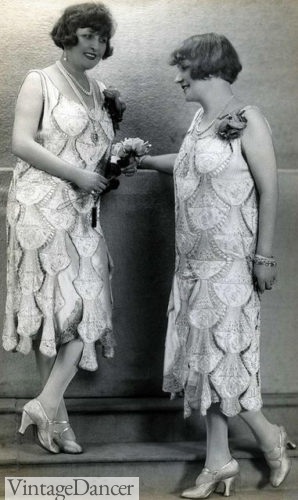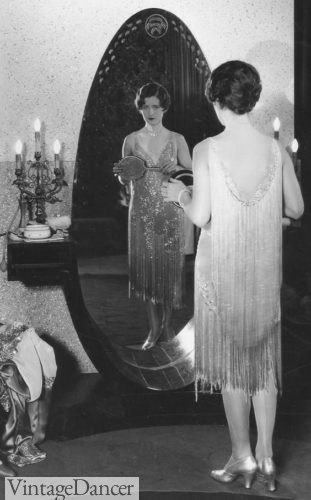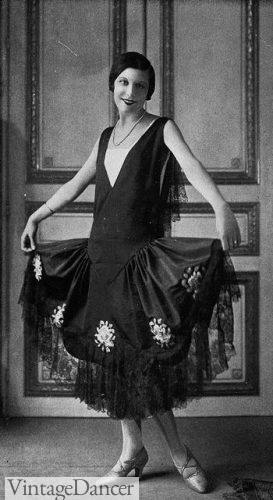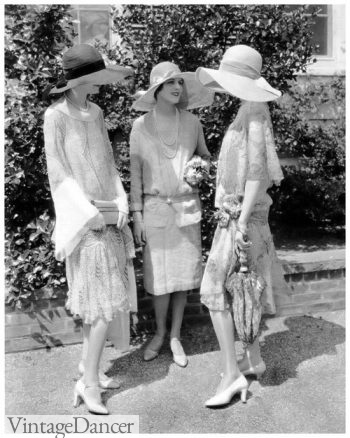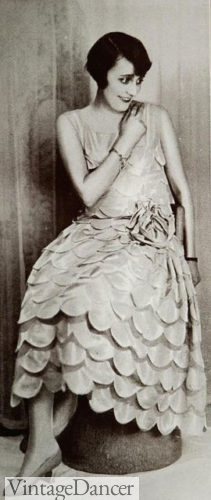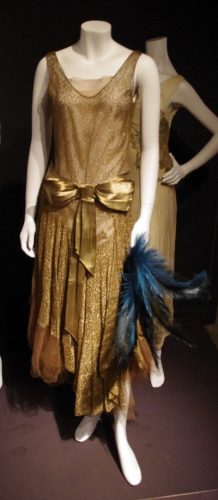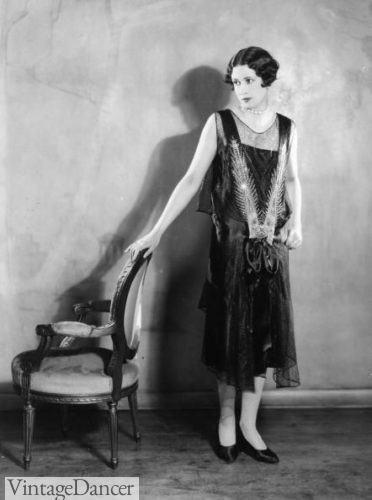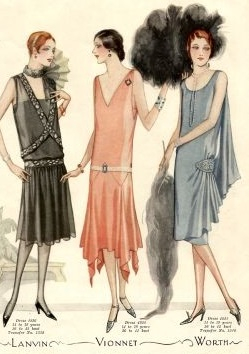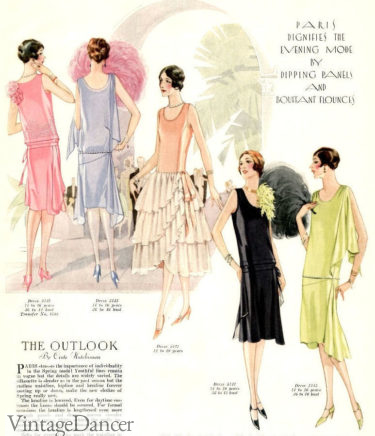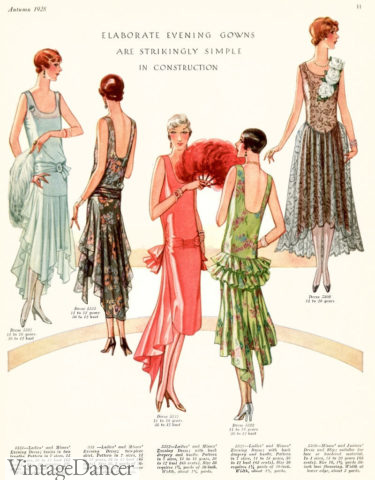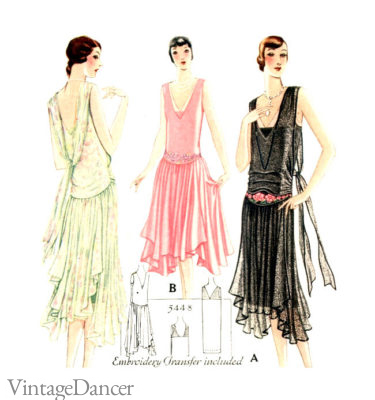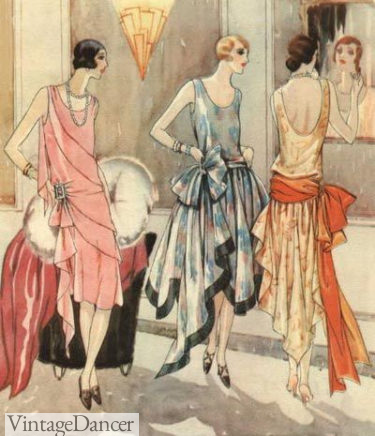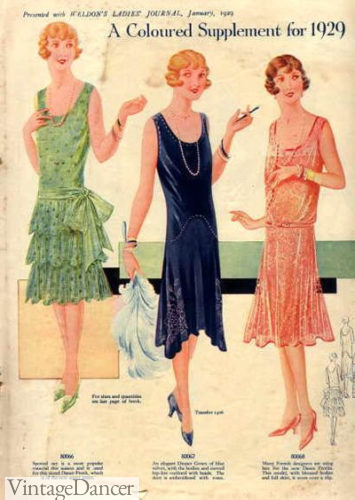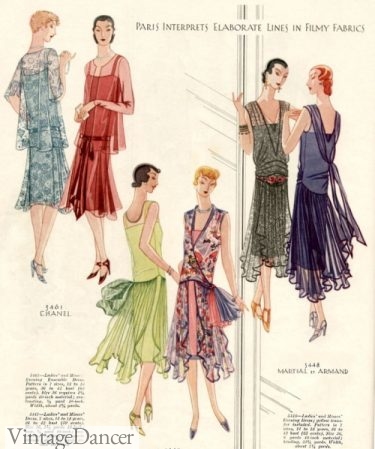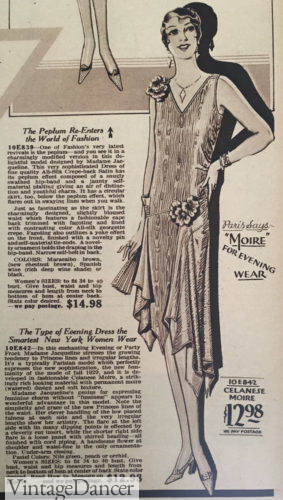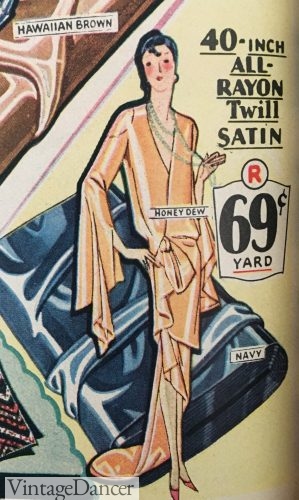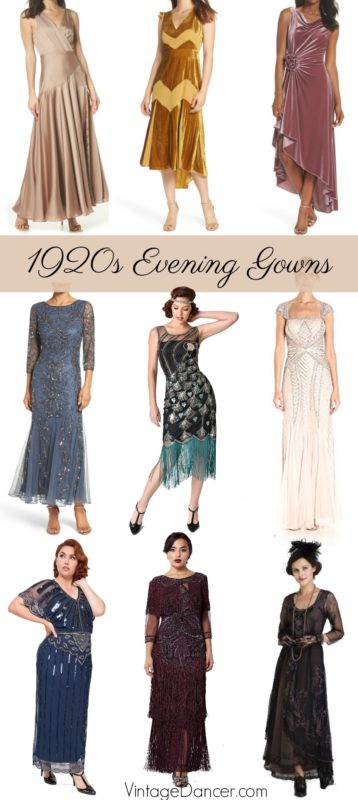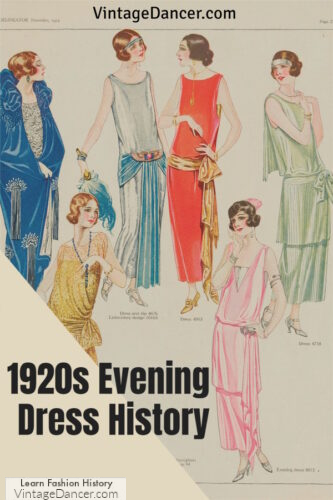
Historical inaccuracies aside, the 2013 Great Gatsby movie’s depiction of the infamous party at Gatsby’s mansion was a showcase of everything glamorous about the roaring twenties. All of the simplicity and girlish styles of 1920s day and afternoon dresses disappeared on women’s 1920s evening dresses. Glitz and glam, rich and flashy — those were the only rules governing party dresses.
Whatever a woman could afford, she wore with great expense when she dressed up for a night on the town. Perhaps dinner and dancing at a swanky night club followed by a risky nightcap at the local speakeasy, or for the moral citizens a night at the opera, ballet or theater would be the occasion. Special occasions called for the best evening gowns and fanciest accessories.
1920s Evening Dresses Go Bare
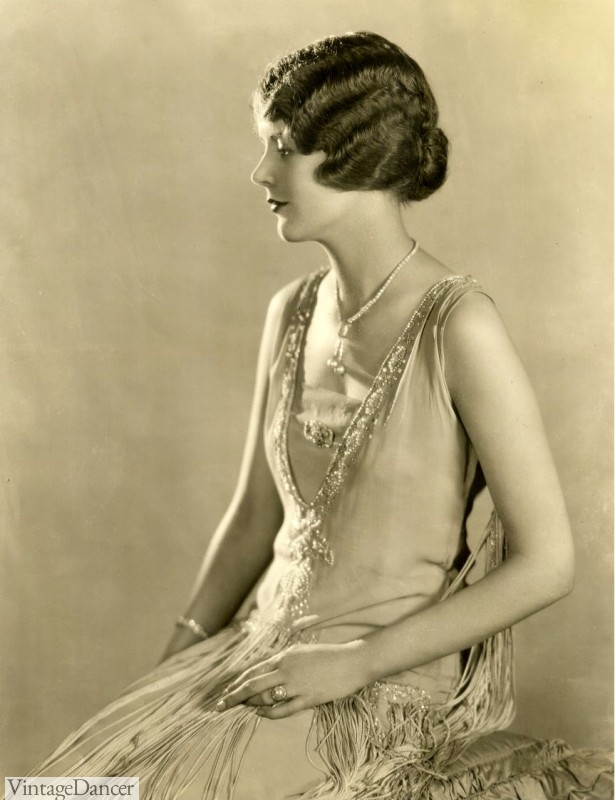
1926 June Collyer V Cut Beaded Chiffon Dress
In general, 1920s evening gowns separated themselves from formal afternoon dresses by going sleeveless. Bare arms were wrapped in silk shawls, furs, caplets, and the hands of a special gentleman for the night. Dresses were designed to be as loose as day dresses, but were made with the most expensive fabric and trimming a woman could afford.
Beading was all the rage for the entire decade. At first, beads were placed in small clusters to accent the hip, bust, shoulder, or hem. Pretty soon, all-over glass beading on net created the “fabric” with elaborate Art Deco designs. These gowns are what you probably think of as flapper dresses and rightly so. Handmade in Paris, they were extremely expensive to own. Only the wealthiest of flappers could afford one.
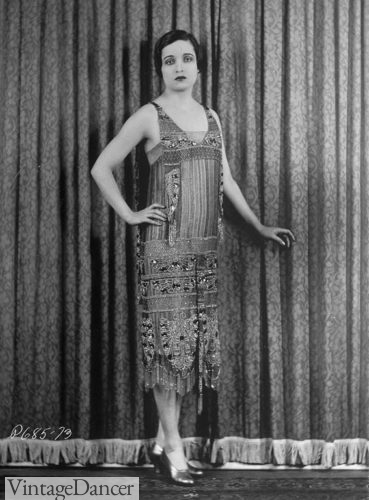
Actress Alice Joyce 1926 bead and fringe dress
The majority of ’20s formal dresses were made of layers of light pastel chiffon or heavy velvet in winter. Clusters of crystals and beads accented the layers. Gold or silver metal embroidery created the illusion of beadwork, especially in the later years.
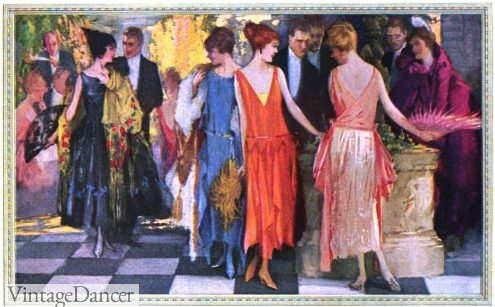
1922 evening party
Designers from Callot Soeurs loved using metal sequins (also called spangles) on their designs. When “gold sequin-like disks” were discovered on clothing in King Tuts Tomb in 1922, the sequin industry boomed. Metal bits all over a dress made them heavy, so they were only used sparingly.
If metal sequins and thread were too expensive to purchase, a shiny taffeta dress homemade with large silk flowers acted as luxury bits for lower class party dresses.
Bare arms weren’t the only source of skin exposure. Evening gowns grew shorter into dance dresses, copied from sporty day dresses. Long gowns persisted in the winter months, but they, too, were not modest. The front round or square neckline remained high but the backs? Forget it. They plunged lower and lower, reaching the waist by the 1930s.
Needless to say, formal dresses did not need any bras or undergarments. Even stockings attempted to reveal as much skin as possible. Very sheer, nude colored tights were worn along with sheer pastel peach or apricot colors.
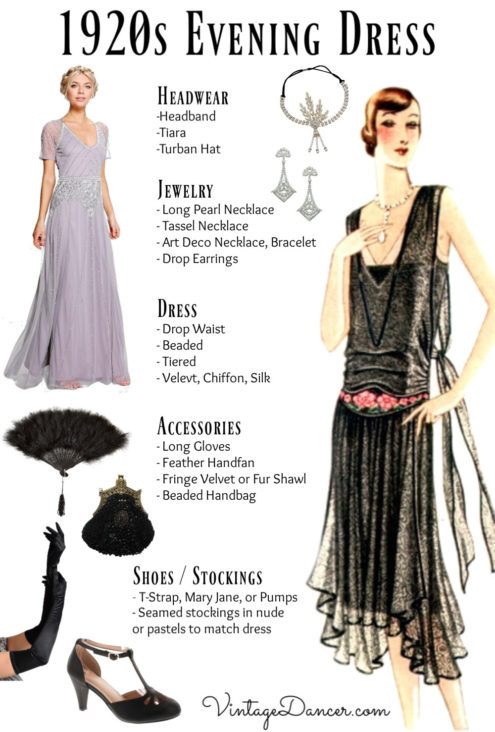
How to accessorize a 1920s evening dress
Evening accessories were just as elaborate as the dresses. Beaded or metal mesh handbags, bejeweled cigarette holders, crystal headdresses and hair ornaments, and lavish shawls were all part of the party dress. In 1922, the evening turban and beaded skull caps became one of the few headwear items made especially for evening wear.
1920s Formal Dress Styles
This series illustrates the development of evening dress styles over the decade.
- 1921 Full Skirt/Pannier Effect Dress- (WSU Collection)
- 1922 – Beaded evening dress with trailing cape effect
- 1921 Evening Dress in the Greek Style
- 1922 Chemise Dress- Straight Shape, Full Beading, and Floor Length
- 1922 Frances Alda in an Egyptian Inspired Gown
- 1922 Low back dress with back hip sash
- 1923 Uneven hem dress with side bow
- 1924 Shapeless Beaded Dresses with loose hip sash
- 1925 Gold Lace, uneven hem gown
- 1925 Gold Beads and Meta Embroidery
- 1926 Actress Alice Joyce in a Chemise Beaded Dress
- 1926 Callot Soeurs Asian inspired gown with trailing side panels
- 1927 silk and velvet long sleeve dress with gathered skirt
- 1927 two tone sheer beading over pink chiffon
- 1928 tiered velvet short party dress
- 1928 Belted evening dress with inset tiers
- 1929 Long dresses return with flared skirts
- 1929 Ruffles, sleeves, and a more defined silhouette formed the shape of 1930s fashion
Timeline of Designer 1920s Evening Gowns
It is sometimes difficult to date a specific ’20s formal dress because most styles lasted the entire decade. If a Paris designer came out with something new, it took 6 months to 3 years to become mainstream, and then it stayed in fashion for a few more years after that. That said, Vogue magazine tracked the major trends in 1920s evening dresses through each season and year. Here is what they said:
1920-1921: The full skirt or pannier hip flounces remained popular through the next year or two. Lanvin spearheaded the Robe de Style gowns which were copied by other designs. Lanvin continued the style, while other designers preferred the straight line, long, and fully beaded dress.
- 1921 draped Grecian style evening dresses
- 1921 evening and party dresses (Purple dress is Robe de Style)
1922-1923: The straight line, almost no defined waist, ‘chemise’ dress remained popular. They were very long, and even when the day trend was to go shorter, evening gowns kept their length. Round boat Bateau necks were the most common shape of formal wear. Dresses that had some kind of waist were accented with oversized bows on the center-low back or to one side of the hips. Turbans and beaded headdresses were all the rage in 1923.
- 1923 evening dress and opera coat
- 1923 long formal gowns
1924: Designer Chanel insisted on cutting the length of evening gowns and turned them into shorter more danceable ‘dance frocks.’ The torso of the dress was quite long with very low necklines, bare backs and heavy decorations of gold embroidery and dangling crystal gems.
Lace and chiffon were the preferred summer fabrics while velvet in beige, black, or green were the favored colors in winter. Many dresses started to have some kind of skirt effect with flounced or feather hemlines.
Chiffon ‘capes’ flowed down the back of dresses or off the sleeves creating points on either side of the skirt. It was a big year for formalwear designers.
- 1924 long evening gowns in the draped effect
- 1924 afternoon or party dress with pleat, lace tiers or all over beading
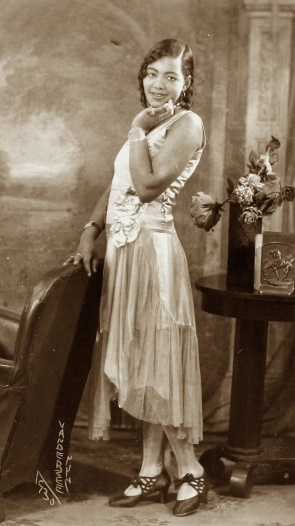
Uneven hem party dress (look at those fabulous shoes)
1925: Low low backs were still on-trend. Skirts featured layers, tiers, flounces, and the first sighting of fringe. Fringe was used as an accent on silk dresses, not to cover the entire gown. A few heavily fringed dresses were adopted by dancing showgirls. They liked the movement fringe or feathers gave while dancing.
Unfortunately, the fringed dress has become the stereotype for “flapper dress,” when in reality they were worn only by a few performers.
- 1925 beaded evening gowns
- Long fringe covers this beautiful dress with silver pumps to match.
1926: The styles were still in line with the past two years. Backs continued to be bare with front necklines dropping ever so slightly, too. Heavy beading also continued on an assortment of pastel lace, crepe, chiffon, satin, and taffeta. Hemlines were straight or uneven with even bigger puffy bows at the back, side, or front hip.
- 1926 Entr’acte Robe du Soir de la Maison Agnes
- 1926 tea party dresses
1927: Dresses were straight up top with a fuller skirt on the bottom. Necklines now strayed away from just round to become oval, V-neck, or square. Hip flounces, flying back and side panels, and a bustle effect on the back called attention to the open backs yet again. New bright colors were in favor: black, white, yellow, lavender blue, turquoise, pale green, terracotta, and Chanel’s favorite: lipstick red.
- 1927 Robe de Style with a petal skirt
- 1920s gold evening dress at London Fashion and Textile Museum
- 1927 beaded evening dress
- 1927 evening dresses and feather handfans
1928: Short was in. Evening and day dresses started to be built from the same patterns with only the material and beading to set them apart. New colors were seen for winter: burgundy, midnight blue, and autumn red. The handkerchief hem was especially popular with multi-points on the bottom hem. It allowed dresses to appear long while standing while still flashing a lot of leg while dancing or sitting.
- 1928 evening dresses, slim tiered skirts
- 1928 longer length dresses with uneven hems
- 1928 hanky hem evening dresses
- Mode 1928 uneven hem dresses and big bows
1929: Finally, some sleeves were added back onto formal gowns (with much relief to most women). Long sleeves, 3/4 sleeves, capes, or cap sleeves were all added to gowns. The first “hi-low” hem was seen, meaning the back of the gown trailed on the floor while the front hung around the mid-shin. There was some shape and definition to the figure as well. These were the beginnings of the more feminine gowns that would be in vogue in the 1930s and epitomized during Hollywood’s Golden years.
- 1929 spring evening dresses
- 1929 party dresses with capes
- 1929 uneven hem party dress
- 1929 “hi low” draped gown
Shop 1920s Style Evening Gowns
Debbie Sessions has been teaching fashion history and helping people dress for vintage themed events since 2009. She has turned a hobby into VintageDancer.com with hundreds of well researched articles and hand picked links to vintage inspired clothing online. She aims to make dressing accurately (or not) an affordable option for all. Oh, and she dances too.

